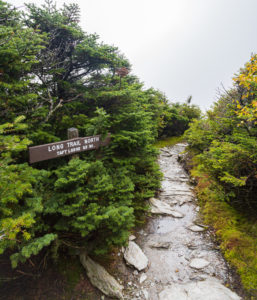
The mission of the Green Mountain Club is to make the Vermont mountains play a larger part in the life of the people by protecting and maintaining the Long Trail System and fostering, through education, the stewardship of Vermont’s hiking trails and mountains.
History of the Long Trail
The history of the Green Mountain Club is the history of the Long Trail. The Long Trail is the oldest long-distance hiking trail in the United States. The idea was conceived by James P. Taylor (1872-1949) as he waited for the mist to clear from the summit of Stratton Mountain.
1910
The Green Mountain club was formed at a March 11th meeting in Burlington.
1910-1920
Work began in the Camel’s Hump and Mount Mansfield areas, and by the end of 1912, a path was cleared from Sterling Pond to Camel’s Hump. In the first decade of the Club, members built 209 miles of trail and provided forty-four overnight facilities, fourteen of which were raised by the GMC.
1930
The final link of the Long Trail was cut to Canada.
1931
The Club celebrated its twenty-first birthday with a party and the lighting of flares from mountaintop to mountaintop along the spine of the Green Mountains. With the trail completed, the Club continued to expand its network of shelters. The Club’s board of trustees authorized formation of a salaried Long Trail Patrol led by Roy O. Buchanan. Each summer, Buchanan and groups of students worked on trail maintenance, construction of new shelters, and repairs to existing ones.

Mid 1930s
When a scenic highway called the Green Mountain Parkway was proposed for the length of the Green Mountain Range, the Club mounted energetic opposition. Vermonters ultimately rejected the idea in a statewide referendum.
1958
When the U.S. Air Force dropped its plan to erect a missile communications facility on the Chin of Mount Mansfield, it was in part due to GMC opposition. During most of its history, the GMC has chosen not to become involved in national conservation issues but has steadfastly worked to preserve the character and value of the Long Trail and the Green Mountains, including the opposition of both the Parkway and missile communications facility.

1950-1960
Shelter construction and reconstruction accelerated between 1950 and 1960. By the time the 50th Anniversary Edition of the GMC Long Trail Guide was published in 1960, there were 61 shelters along the trail.
1966 and 1975
Responding to heavy trail traffic, the Club launched a variety of initiatives, including removal of dumps at shelters and promotion of a “carry-in, carry-out” policy, dissemination of information on responsible trail and camping practices. Caretakers were stationed at the most popular shelters and ranger-naturalists (now summit caretakers) were stationed on the summits of Mount Mansfield and Camel’s Hump, where they taught hikers to respect the peaks’ rare, fragile alpine ecosystems.

1971
The Vermont Legislature passed a resolution recognizing the Club as “the founder, sponsor, defender, and protector” of the Long Trail System and delegating to it responsibility for developing policies and programs for “the preservation, maintenance, and proper use of hiking trails for the benefit of the people of Vermont.”
1986
The Long Trail Protection Program was launched. As of 2020, the campaign has successfully protected all but 6.5 miles of the Long Trail. Learn more about conservation efforts here
1992
The Club bought the former 1836 May Farm in Waterbury Center on Route 100, a popular tourist avenue into the Green Mountains. After renting space for many years, first in Rutland, then in downtown Montpelier, the GMC was finally its own landlord. In addition to administrative offices, the headquarters houses the GMC’s visitor center and information and education services.

Today
Although different generations of GMCers have faced different challenges–from pioneer trail blazing to environmental concerns and land acquisition–the Club’s main responsibility remains the same today as it was in 1910: to maintain and protect the Long Trail for all Vermonters, now and in the future.
You can find GMC’s annual reports here


















